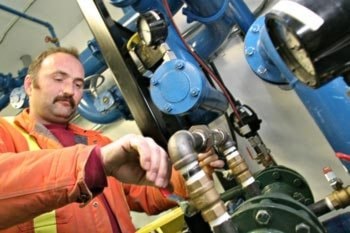HAINES JUNCTION
Mayor John Farynowski dreams of a future where Haines Junction chimneys don’t puff smoke.
In fact, one day he hopes village homes can stop burning fossil fuels altogether.
“To have a town North of 60 with no chimneys, that’s pretty unique,” said Farynowski on Tuesday, while sitting in his Haines Junction office.
Farynowski has been searching out greener ways to heat the community, and two years ago the answer presented itself in a way that he couldn’t ignore.
It came gushing through the ground.
The story begins in 2002, when the village was drilling for a new source of drinking water.
Crews dug 300 metres and found nothing.
Then they pushed a bit further.
At about 330 metres they hit the mother lode, so to speak.
There was no gold, but the warm water aquifer they hit was artesian, and found to have enough heat and pressure to keep the whole village warm through the winter.
An artesian aquifer has a lot of hydrological pressure that forces the water to flow upwards out of a well without the need for pumping.
“We were looking for 50 gallons a minute and we ended up with 200,” said Farynowski.
It took two weeks to get the gushing under control, said the mayor with a laugh.
And there’s no end in sight.
He’s been told the aquifer has a capacity to pump 800 gallons a minute sustainably for at least 1,000 years, Farynowski added.
The most surprising aspect of the find was the pristine condition of the water, said Farynowski.
The village just adds chlorine, which is mandated by law, and the water is ready to drink.
So far, tests on the water’s source have been inconclusive — some experts say it’s 10,000 years old and others pegged it at 100.
The water is cool to the touch, but its 17 degrees is more than enough, theoretically, to heat homes and public buildings in this village of nearly 800.
It’s a “low-grade” heat, said Ron Gee, technical consultant with the Energy Solutions Centre.
“It’s not something that would scald you. You can touch it, as opposed to some places like Iceland; when they talk about geothermal they’re talking about geysers.”
When the village realized it was sitting on an amazing resource, it began researching how to best use it.
A $300,000 commissioned study gave the village all the information it needed to go green.
The report estimated it would cost $30 million to reconfigure the whole village.
The heating process is complicated, but put simply — it begins when the water goes through a heat-pump process, which works much like a refrigerator.
The heat in the water is used to help boil a refrigerant (a fluid with a low-boiling temperature).
When the refrigerant is condensed, then brought back into liquid form it releases heat and that’s what can be used to warm a building.
“It’s a very clean source of heat; there are no hydrocarbons and no diesel — there’s no combustion in the process although you do require electricity,” said Gee.
Although the outset costs are high to retrofit a building to use a water-pump system, tapping the aquifer will save the community money over time and reduce pollution — something you cannot put a price tag on, said Farynowski.
“We’re a small municipality with a small budget; we need to have a go-slow approach,” he said.
“We’re not going to do anything big; we’re not going to get rich on it.”
Originally the village pushed to change a bunch of buildings, like the school, the arena and the convention centre to geothermal heat.
It applied to Ottawa to fund the project, but the federal election put the brakes on it, said Farynowski.
“I’m sure we will get it, but it’ll just take longer,” he said.
Now the village is moving one step at a time.
Currently the village uses its water to heat its small pump house, which supplies water to about 800 residents — people living in Haines Junction and in Champagne/Aishihik.
It’s a task that used to cost the village $300 a month, but now the bill comes in at about three dollars a month for electricity, said Farynowski.
This week the village took another leap forward.
Wednesday it was given word it was approved for funding to switch its St. Elias Convention Centre from conventional heating to geothermal, through the Federation of Canadian Municipalities green fund.
The bill to change the facility’s system will come in around $200,000, said Farynowski.
But that change will halve heating costs in the facility from $30,000 a year to about $15,000, he said.
The village has also applied to use the geothermal source to heat its new seniors’ complex, which is slated to open its doors to tenants sometime next summer, said Yukon Housing spokesperson Doug Caldwell.
These sorts of aquifers have been found in other places around the territory.
Riverdale has its own warm water resource, which comes in at about six or seven degrees. It’s used in a small pump system to heat the Whitehorse Fish Hatchery building.
Mayo has a similar warm water resource, but its water is not fit to drink, which poses problems for the system.
